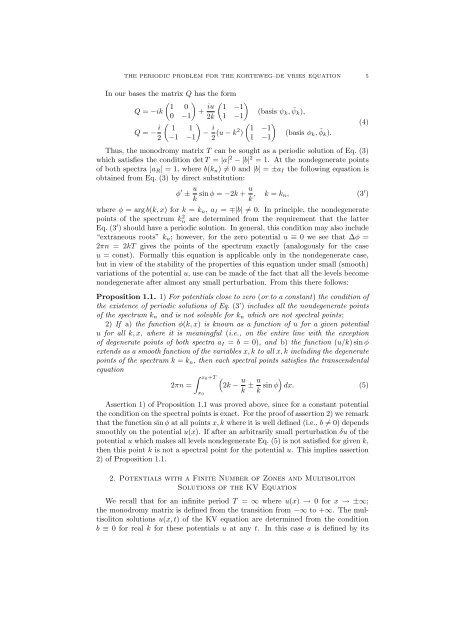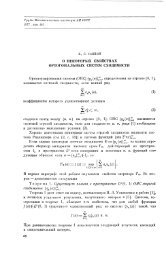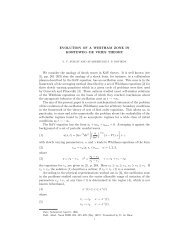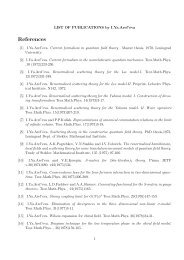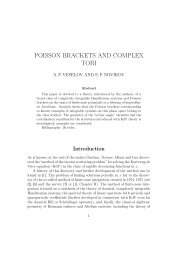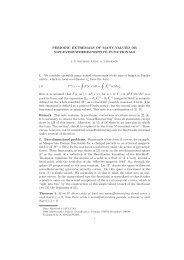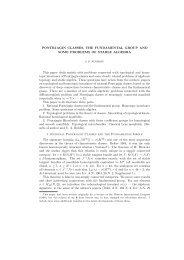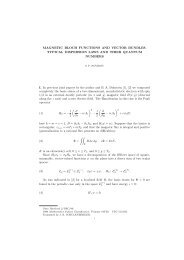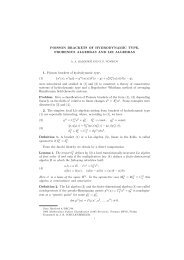A periodic problem for the Korteweg-de Vries equations, I.
A periodic problem for the Korteweg-de Vries equations, I.
A periodic problem for the Korteweg-de Vries equations, I.
Create successful ePaper yourself
Turn your PDF publications into a flip-book with our unique Google optimized e-Paper software.
THE PERIODIC PROBLEM FOR THE KORTEWEG–DE VRIES EQUATION 5In our bases <strong>the</strong> matrix Q has <strong>the</strong> <strong>for</strong>m( ) 1 0Q = −ik + iu ( ) 1 −1(basis ψ0 −1 2k 1 −1k , ¯ψ k ),Q = − i ( )1 1− i ( )1 −12 −1 −1 2 (u − k2 )(basis φ1 −1k , ¯φ k ).Thus, <strong>the</strong> monodromy matrix T can be sought as a <strong>periodic</strong> solution of Eq. (3)which satisfies <strong>the</strong> condition <strong>de</strong>t T = |a| 2 − |b| 2 = 1. At <strong>the</strong> non<strong>de</strong>generate pointsof both spectra |a R | = 1, where b(k n ) ≠ 0 and |b| = ±a I <strong>the</strong> following equation isobtained from Eq. (3) by direct substitution:(4)φ ′ ± u k sin φ = −2k + u k , k = k n, (3 ′ )where φ = arg b(k, x) <strong>for</strong> k = k n , a I = ∓|b| ≠ 0. In principle, <strong>the</strong> non<strong>de</strong>generatepoints of <strong>the</strong> spectrum k 2 n are <strong>de</strong>termined from <strong>the</strong> requirement that <strong>the</strong> latterEq. (3 ′ ) should have a <strong>periodic</strong> solution. In general, this condition may also inclu<strong>de</strong>“extraneous roots” k n ; however, <strong>for</strong> <strong>the</strong> zero potential u ≡ 0 we see that ∆φ =2πn = 2kT gives <strong>the</strong> points of <strong>the</strong> spectrum exactly (analogously <strong>for</strong> <strong>the</strong> caseu = const). Formally this equation is applicable only in <strong>the</strong> non<strong>de</strong>generate case,but in view of <strong>the</strong> stability of <strong>the</strong> properties of this equation un<strong>de</strong>r small (smooth)variations of <strong>the</strong> potential u, use can be ma<strong>de</strong> of <strong>the</strong> fact that all <strong>the</strong> levels becomenon<strong>de</strong>generate after almost any small perturbation. From this <strong>the</strong>re follows:Proposition 1.1. 1) For potentials close to zero (or to a constant) <strong>the</strong> condition of<strong>the</strong> existence of <strong>periodic</strong> solutions of Eq. (3’) inclu<strong>de</strong>s all <strong>the</strong> non<strong>de</strong>generate pointsof <strong>the</strong> spectrum k n and is not solvable <strong>for</strong> k n which are not spectral points;2) If a) <strong>the</strong> function φ(k, x) is known as a function of u <strong>for</strong> a given potentialu <strong>for</strong> all k, x, where it is meaningful (i.e., on <strong>the</strong> entire line with <strong>the</strong> exceptionof <strong>de</strong>generate points of both spectra a I = b = 0), and b) <strong>the</strong> function (u/k) sin φextends as a smooth function of <strong>the</strong> variables x, k to all x, k including <strong>the</strong> <strong>de</strong>generatepoints of <strong>the</strong> spectrum k = k n , <strong>the</strong>n each spectral points satisfies <strong>the</strong> transcen<strong>de</strong>ntalequation∫ x0 +T (2πn = 2k − ux 0k ± u )k sin φ dx. (5)Assertion 1) of Proposition 1.1 was proved above, since <strong>for</strong> a constant potential<strong>the</strong> condition on <strong>the</strong> spectral points is exact. For <strong>the</strong> proof of assertion 2) we remarkthat <strong>the</strong> function sin φ at all points x, k where it is well <strong>de</strong>fined (i.e., b ≠ 0) <strong>de</strong>pendssmoothly on <strong>the</strong> potential u(x). If after an arbitrarily small perturbation δu of <strong>the</strong>potential u which makes all levels non<strong>de</strong>generate Eq. (5) is not satisfied <strong>for</strong> given k,<strong>the</strong>n this point k is not a spectral point <strong>for</strong> <strong>the</strong> potential u. This implies assertion2) of Proposition 1.1.2. Potentials with a Finite Number of Zones and MultisolitonSolutions of <strong>the</strong> KV EquationWe recall that <strong>for</strong> an infinite period T = ∞ where u(x) → 0 <strong>for</strong> x → ±∞;<strong>the</strong> monodromy matrix is <strong>de</strong>fined from <strong>the</strong> transition from −∞ to +∞. The multisolitonsolutions u(x, t) of <strong>the</strong> KV equation are <strong>de</strong>termined from <strong>the</strong> conditionb ≡ 0 <strong>for</strong> real k <strong>for</strong> <strong>the</strong>se potentials u at any t. In this case a is <strong>de</strong>fined by its


